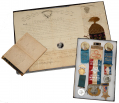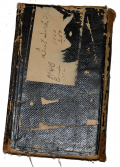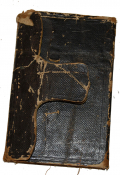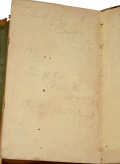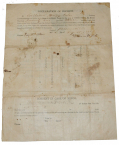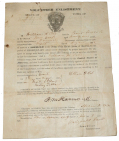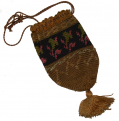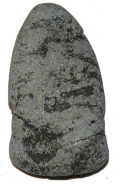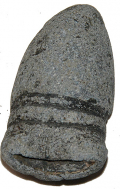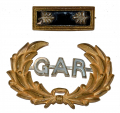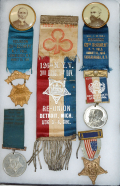site search
online catalog
UNION SOLDIER GROUPING ID’D SERGT. WILLIAM H. COLE, “C” CO., 126TH NEW YORK INFANTRY – WOUNDED AT GETTYSBURG, 7/3/1863 & THE WILDERNESS, 5/6/1864
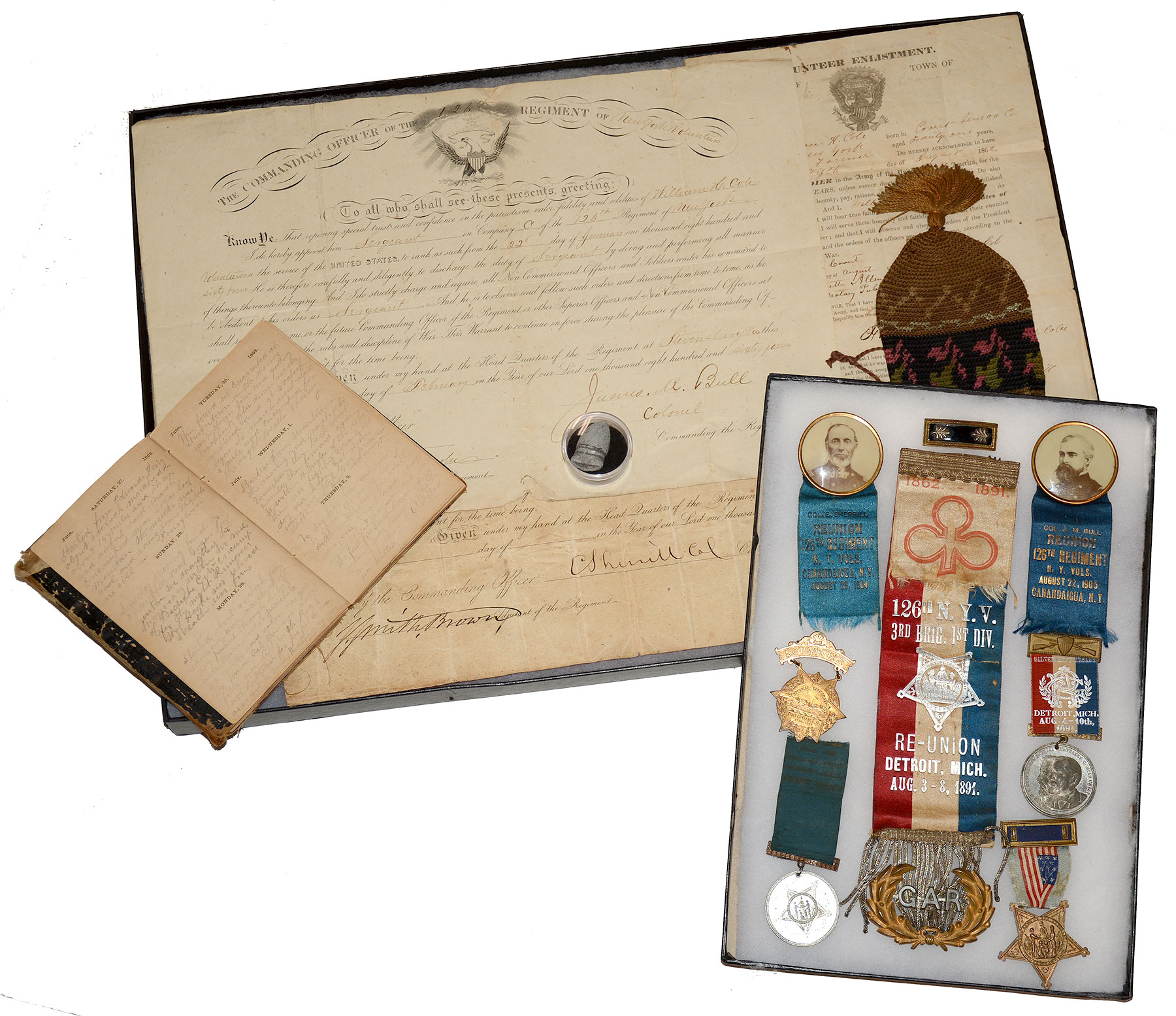
$3,950.00 SOLD
Quantity Available: None
Item Code: 1083-03
The first part of the grouping —mounted in black rider case, 14” x 20--contains Cole’s 1863 pocket diary (entries from January 1st through Sept.1st, including the Battle of Gettysburg) and his New York enlistment and regimental corporal and sergeant promotion documents. Also a hand knit gold tobacco pouch, plus the Confederate two-ringer bullet with which he was wounded at Gettysburg. The documents exhibit wrinkles, fold-marks & slight fading. Tobacco pouch nicely intact. Confederate two-ringer flattened and dented at base. Leatherette flap cover pocket diary exhibits considerable scuffing. Hinges fine. Pencil entries somewhat light but entirely legible. Lower right Riker box corner exhibits wear.
The second part—mounted in a black Riker box, 8” x 12—contains two 126th New York portrait-medallion reunion ribbons (1904 & 1905), Two ribbons from the “Silver Anniversary” G.A.R. Grand Encampment at Detroit, Michigan, Aug. 3-8, 1891, an indistinct G.A.R. ribbon, an 1894 Ft. Defiance centenary badge, a standard G.A.R. membership badge w/2nd Lieutenant shoulder strap clasp, and a G.A.R. Lieut. Col. shoulder strap badge. All ribbons in very good condition. The large 1891 GAR Grand Encampment ribbon is exceptionally gaudy and colorful. Riker box condition VG.
At age 21, Private William H. Cole was mustered into Co. “C”, 126th Infantry. He was listed as a POW (Harper’s Ferry /paroled Sept 1862), and was wounded at Gettysburg 7/2/1863 and at the Wilderness 5/6/1864.He was discharged for wounds on 1/27/1865.
The 126th New York Infantry was organized in August 1862 and in the following month their brigade was captured at Harper’s Ferry by Stonewall Jackson’s Troops. Paroled, they served in the Washington defenses until joining the Army of the Potomac on the march to Gettysburg in June 1863, attached to Hancock’s 2nd Corps, 3rd Division, 3rd Brigade. In late afternoon of the 2nd of July, Willard’s 3rd Brigade was shifted Ziegler’s Grove to the left and thrown forward to blunt and stop Barksdale’s charge coming across through the Peach Orchard, which they did while sustaining heavy casualties, including Private William Cole, including Private William Cole.
Following Gettysburg, this brigade participated in the major battles of the Army of Northern Virginia through Cold Harbor and the Siege of Petersburg. After participating in the May 23rd Grand Review, the unit was mustered out. June 3, 1865. During service it lost 153 men killed or mortally wounded and 123 by disease for a total of 276.
Private Cole’s 1863 pocket diary contains three entries per page, written in pencil. Though the writing is light, it is mostly legible to the naked, and completely legible under strong light or with magnifying glass. Excerpts as follows:
June 16—“Was on guard today, then was new that the Rebs was in Pennsylvania and there was several army corps came around Centreville at night. The band was playing…”
June 17—“This morning the troops commanded to move 2 o’clock and have been going all day. All Hooker’s command is on the was to off the Rebs.
.
June 26—“the whole Hooker’s force crossed the river and expect an engagement…”
June 28—"Sunday morning found us encamped near “Sugar Loaf Mountain.We marched to…within 2 miles of Fredrick city. Rumored that Hooker was relieved.”
June 29—"Started about 8 O’clock. From...and marched all day. Passed through Liberty and Union Bridge. Marche 32 miles and when we got to Union City there was not 50 men left in the regiment. I was detailed for picket as soon as we got to Union.”
July 1—"Started from Union Town in the morning and marched to Jamestown then back about 2 miles. Then forward within 4 miles of the Rebs. There was fighting nearly all day. Our men got drove…We took 500 prisoners…”
July 2—"Today has been one never to be forgot. We lay in line of battle until about 5 o’clock. when our brigade made a charge on the Rebs. I was wounded in the first fire. Such cannonading never was heard since the war broke out and Co. Willard was killed.”
July 3—"I was at the hospital under an apple tree about noon. The Rebs began to shell the hospital and I got away. The wounded was removed about a mile to the rear in the night. Geo. Was brought down body wound. The Rebs was badly cut up.”
July 4—"This morning found me to the hospital in the woods. There was 2000 wounded in our division. Col. Sherril was killed today at 8 o’clcok. The Rebs commenced to retreat. There was a heavy shower today.”
July 5—"this is the sabbath and still we remain in the woods. The doctor decided to take George’s leg which they done and the boy had to go leaving no one to take care of it.”
July 6—"Today we lay in the wood and such sights I never want to see again. The regiment marched and good news from the battle field. George’s leg is as well as can be expected.”
July 7—"Today has been a solemn one. We lay in the woods all day with thousands of wounded and dying around us. Such suffering I never saw before.”
July 8—"This morning about 2 o’clock am it commenced to rain and continued until 10. It raised the river so that it drowned out all the wounded and came near drowning some. It was an awful time. Mean were floating down the river. A sight I never want to see again.”
July 9—"This morning I awoke and found myself as usual in the woods. George had a rather hard night. Some folks cam in from…Lots of citizens came in and brought us something to eat.”
July 10—"George C. King died at 12 o’clock pm in the morning. Dug a grave and about 9 o’clock we deposited (?) his remains.”
July 11—"I had my wound dressed in a hospital where we lay our weary limbs down no rest.”
Private Cole does not describe the wound he received July 2, 1863, but, since he continued writing his diary even while in the woods or hospital, it seems obvious that it was a flesh wound affecting no bones or vital organs--in other words, a wound in which the bullet that struck him (and which he kept) was easily extracted. The right-hand wound later received at the Wilderness did however affect him, and was in fact instrumental in securing him a discharge for disability, January 7, 1865.
In all, a highly unusual and superb Gettysburg set. Fine memento of a private of the 126th New York wounded during Barksdale’s Charge, July 2, 1863. In two Riker boxes, accompanied by a brief amount of biographical material. Invites further research via Cole’s service record in the National Archives concerning the details of Cole’s Gettysburg wound. [jp] [ph:L]
~~~~~~~~~~~~~~~~~~~~~~~~~~~~~~~~~~~
THIS ITEM, AS WITH ALL OTHER ITEMS AVAILABLE ON OUR WEB SITE,
MAY BE PURCHASED THROUGH OUR LAYAWAY PROGRAM.
FOR OUR POLICIES AND TERMS,
CLICK ON ‘CONTACT US’ AT THE TOP OF ANY PAGE ON THE SITE,
THEN ON ‘LAYAWAY POLICY’.
THANK YOU!
Inquire About UNION SOLDIER GROUPING ID’D SERGT. WILLIAM H. COLE, “C” CO., 126TH NEW YORK INFANTRY – WOUNDED AT GETTYSBURG, 7/3/1863 & THE WILDERNESS, 5/6/1864
For inquiries, please email us at [email protected]
Most Popular
Historical Firearms Stolen From The National Civil War Museum In Harrisburg, Pa »
Theft From Gravesite Of Gen. John Reynolds »
Cavalry Carbine Sling Swivel »
Fine Condition Brass Infantry Bugle Insignia »
featured item
DAGUERROTYPE IN UNIFORM OF LEWIS HENRY LITTLE, BREVET FOR GALLANT AND MERITORIOUS CONDUCT AT MONTEREY 1846; KILLED IN ACTION AS CONFEDERATE BRIGADIER GENERAL AND DIVISION COMMANDER AT IUKA 1862
This very clear sixth-plate daguerreotype dates about 1850 and shows Lewis Henry Little, usually referred to by his middle name, as a Captain in the 7th U.S. Infantry. Born in Maryland in 1817, he was appointed 2nd Lieutenant in the 5th US Infantry… (1138-1808). Learn More »



